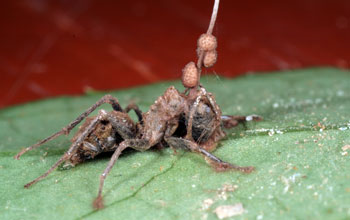Domain- Eukarya
Kingdom- Fungi
Phylum- Ascomycota
Class- Sordariomycetes
Order- Hypocreales
Family- Ophiocordycipitacae

Genus- Ophiocordyceps
Species- Ophiocordyceps unilateralis
Domain- O. unilateralis belongs in the domain Eukarya because its cells contain membrane bound organelles (Cain et al. 2008).
Kingdom- The organism is recognized in the kindgdom fungi because it has the characteristics of a normal fungus including cell walls made of chitin and hyphae that digests the organisms food before ingesting (Cain et al. 2008).
Phylum- The zombie ant fungus is in the phyla Ascomycota because it contains the fruiting body called an ascus. The general name for ascomycota is the "sac fungi" (Cain et al. 2008).
Class- O. unilateralis is recognized in the class Sordariomycetes because it produces asci in perithecial fruiting bodies. The term perithecial refers to a flask shaped fruiting body (Zhang 2008).
Order- The fungus is in the order Hypocreales because it has brightly colored spore producing structures (Rogerson 1970).
Family- O. unilateralis belongs to the family Ophiocordycipitaceae, a well known group of parasitic fungi (Sung 2013).
Genus- The genus Ophiocordyceps is characterized by fungi that are parasitic to insects (Hughes 2010).
Species- Ophiocordyceps unilateralis is the species of fungi that specifically infects formicae ants (Hughes 2010).
The phylogenetic tree done as a broad classification was done as part of a study of the phylogeny of the Cordyceps and Clavicipitaceous fungi. The classification present involves the use of maximum parsimony analysis of the 107 (Sung et al. 2013). 1-taxon 5-gene for the different clades of fungi. The results of the experiment showed a tree wtih the likely results of the phylogeny of the different fungi containing that gene (Sung et al. 2013). To see the results click here.
The phylogenetic tree involved in a more specific classification involves looking at five gene regions based on RAxML analysis. The five genes examined in this study were SSU rDNA, LSU rDNA, TEF1, RPB1, and RPB2 (Cordyceps 2013). The tree constructed shows host affiliation and divergence of species within the family Ophiocordycipitaceae (Cordyceps 2013). To see the constructed tree click here.
Fungi have adapted as parsites in many organisms, not just ants. To learn more about fungi parasites in plants click here!